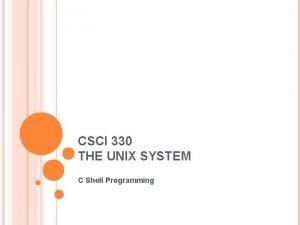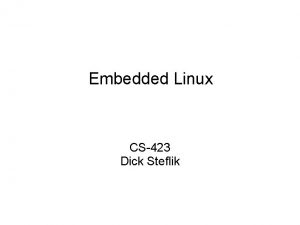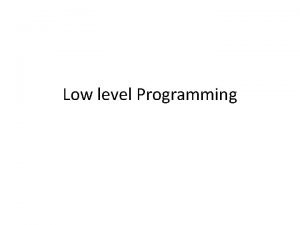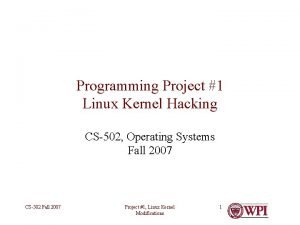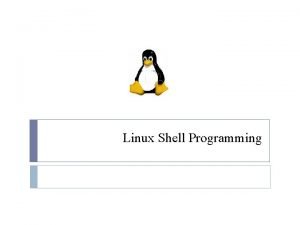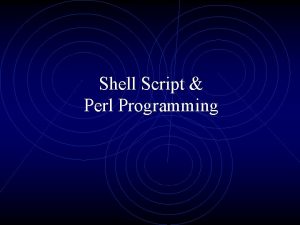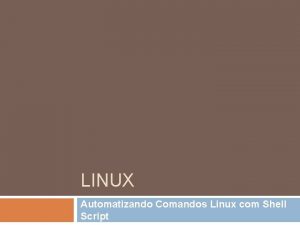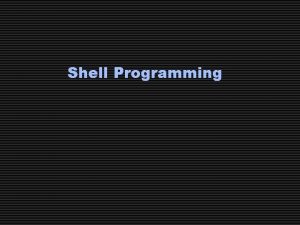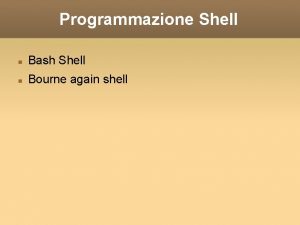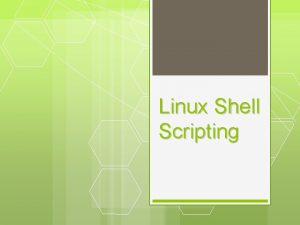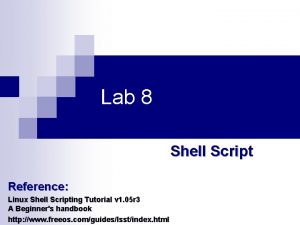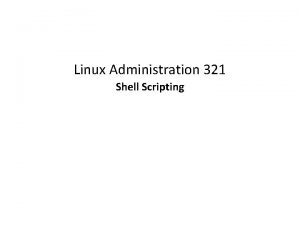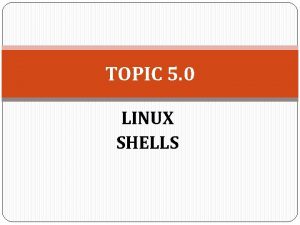Linux Shell Programming The shell of Linux has



















![Example #!/bin/bash if [ -f /etc/fstab ]; then cp /etc/fstab. echo “Done. ” else Example #!/bin/bash if [ -f /etc/fstab ]; then cp /etc/fstab. echo “Done. ” else](https://slidetodoc.com/presentation_image/a488ab68e1acfdc782c997b3aee26895/image-20.jpg)









![Arrays To extract all the elements, use an asterisk as: echo ${arraynames[*]} To see Arrays To extract all the elements, use an asterisk as: echo ${arraynames[*]} To see](https://slidetodoc.com/presentation_image/a488ab68e1acfdc782c997b3aee26895/image-30.jpg)









- Slides: 39

Linux Shell Programming

The shell of Linux has a variety of different shells: Bourne shell (sh), C shell (csh), Korn shell (ksh), TC shell (tcsh), Bourne Again shell (bash). Certainly the most popular shell is “bash”. Bash is the shell that will appear in the GNU operating system. Bash is an sh-compatible shell that incorporates useful features from the Korn shell (ksh) and C shell (csh). It is intended to conform to the IEEE POSIX P 1003. 2/ISO 9945. 2 Shell and Tools standard. It offers functional improvements over sh for both programming and interactive use.

Programming or Scripting ? bash is not only an excellent command line shell, but a scripting language in itself. Shell scripting allows us to use the shell's abilities and to automate a lot of tasks that would otherwise require a lot of commands. Difference between programming and scripting languages: Programming languages are generally a lot more powerful and a lot faster than scripting languages. Programming languages generally start from source code and are compiled into an executable. This executable is not easily ported into different operating systems. A scripting language also starts from source code, but is not compiled into an executable. Rather, an interpreter reads the instructions in the source file and executes each instruction. Interpreted programs are generally slower than compiled programs. The main advantage is that you can easily port the source file to any operating system. bash is a scripting language. Other examples of scripting languages are Perl, Lisp, and Tcl.

The first bash program We must know how to use a text editor. There are two major text editors in Linux: vi, emacs (or xemacs). So fire up a text editor; for example: $ vi & and type the following inside it: #!/bin/bash echo “Hello World” The first line tells Linux to use the bash interpreter to run this script. We call it hello. sh. Then, make the script executable: $ chmod 700 hello. sh $ ls –l -rwx------ hello. sh

The first bash program To execute the program: $ hello. sh -bash: hello. sh: command not found The home directory (where the command hello. sh is located) is not in the variable PATH echo $PATH : bin: /usr/bin: … We must specify the path of hello. sh $/home/srinaldi/Scripts/hello. sh $. /hello. sh

The second bash program We write a program that copies all files into a directory, and then deletes the directory along with its contents. This can be done with the following commands: $ mkdir trash $ cp * trash $ rm -rf trash

Variables We can use variables as in any programming languages. Their values are always stored as strings, but there are mathematical operators in the shell language that will convert variables to numbers for calculations. We have no need to declare a variable, just assigning a value to its reference will create it. Example #!/bin/bash STR=“Hello World!” echo $STR Line 2 creates a variable called STR and assigns the string "Hello World!" to it. Then the value of this variable is retrieved by putting the '$' in at the beginning.

Single and Double Quote When assigning character data containing spaces or special characters, the data must be enclosed in either single or double quotes. Using double quotes (partial quoting) to show a string of characters will allow any variables in the quotes to be resolved $ var=“test string” $ newvar=“Value of var is $var” $ echo $newvar Value of var is test string Usingle quotes (full quoting) to show a string of characters will not allow variable resolution $ var=’test string’ $ newvar=’Value of var is $var’ $ echo $newvar Value of var is $var

Read command The read command allows you to prompt for input and store it in a variable. Example (read. sh) #!/bin/bash echo -n “Enter name of file to delete: ” read file echo “Type 'y' to remove it, 'n' to change your mind. . . ” rm -i $file echo "That was YOUR decision!" Line 3 creates a variable called file and assigns the input from keyboard to it. Then the value of this variable is retrieved by putting the '$' in at its beginning.

Read command Options read –s (does not echo input) read –n. N (accepts only N characters of input) read –p “message” (prompts message) read –t. T (accepts input for T seconds) Example $ read –s –n 1 -p “Yes (Y) or not (N)? ” answer Yes (Y) or not (N) ? Y $ echo $answer Y

Command Substitution The backquote “`” is different from the single quote “´”. It is used for command substitution: `command` $ LIST=`ls` $ echo $LIST hello. sh read. sh PS 1=“`pwd`>” /home/rinaldi/didattica/> We can perform the command substitution by means of $(command) $ LIST=$(ls) $ echo $LIST hello. sh read. sh rm $( find / -name “*. tmp” ) ls $( pwd ) ls $( echo /bin )

Arithmetic Operators + * / ** % plus minus multiplication division exponentiation modulo Example $ $ a=(5+2)*3 echo $a b=2*3 echo $a+$b

Arithmetic Evaluation The let statement can be used to do mathematical functions: $ let X=10+2*7 $ echo $X 24 $ let Y=X+2*4 $ echo $Y 32 Not necessary to use $X to refer to the value of X An arithmetic expression can be evaluated by $[expression] or $((expression)) echo $((123+20)) 143 VALORE=$[123+20] echo $[123*$VALORE] 17589 $ echo $[2*3] $ echo $[8%3]

Arithmetic Evaluation Example (operations. sh) #!/bin/bash echo -n “Enter the first number: ”; read x echo -n “Enter the second number: ”; read y add=$(($x + $y)) sub=$(($x - $y)) mul=$(($x * $y)) div=$(($x / $y)) mod=$(($x % $y)) # print out the answers: echo “Sum: $add” echo “Difference: $sub” echo “Product: $mul” echo “Quotient: $div” echo “Remainder: $mod”

Conditional Statements Conditionals let we decide whether to perform an action or not, this decision is taken by evaluating an expression. The most basic form is: if [expression]; then statements else statements fi the elif (else if) and else sections are optional

Expressions An expression can be: String comparison, Numeric comparison, File operators and Logical operators and it is represented by [expression]: String Comparisons: = != -n -z compare if two strings are equal compare if two strings are not equal evaluate if string length is greater than zero evaluate if string length is equal to zero Examples: [ s 1 = s 2 ] (true if s 1 same as s 2, else false) [ s 1 != s 2 ] (true if s 1 not same as s 2, else false) [ s 1 ] (true if s 1 is not empty, else false) [ -n s 1 ] (true if s 1 has a length greater then 0, else false) [ -z s 2 ] (true if s 2 has a length of 0, otherwise false)

Expressions Number Comparisons: -eq compare if two numbers are equal -ge compare if one number is greater than or equal to a number -le compare if one number is less than or equal to a number -ne compare if two numbers are not equal -gt compare if one number is greater than another number -lt compare if one number is less than another number Examples: [ n 1 -eq n 2 ] (true if n 1 same as n 2, else false) [ n 1 -ge n 2 ] (true if n 1 greater then or equal to n 2, else false) [ n 1 -le n 2 ] (true if n 1 less then or equal to n 2, else false) [ n 1 -ne n 2 ] (true if n 1 is not same as n 2, else false) [ n 1 -gt n 2 ] (true if n 1 greater then n 2, else false) [ n 1 -lt n 2 ] (true if n 1 less then n 2, else false)

Expressions #!/bin/bash # if 0. sh echo -n “Enter your login name: " read name if [ “$name” = “$USER” ]; then echo “Hello, $name. How are you today ? ” else echo “You are not $USER, so who are you ? ” fi #!/bin/bash # if 1. sh echo -n “Enter a number 1 < x < 10: " read num if [ “$num” -lt 10 ]; then if [ “$num” -gt 1 ]; then echo “$num*$num=$(($num*$num))” else echo “Wrong insertion !” fi

Expressions Files operators: -d -f -s -e -s -r -w -x check if path given is a directory check if path given is a file check if path given is a symbolic link check if file name exists check if a file has a length greater than 0 check if read permission is set for file or directory check if write permission is set for a file or directory check if execute permission is set for a file or directory Examples: [ -d fname ] (true if fname is a directory, otherwise false) [ -f fname ] (true if fname is a file, otherwise false) [ -e fname ] (true if fname exists, otherwise false) [ -s fname ] (true if fname length is greater then 0, else false) [ -r fname ] (true if fname has the read permission, else false) [ -w fname ] (true if fname has the write permission, else false) [ -x fname ] (true if fname has the execute permission, else false)
![Example binbash if f etcfstab then cp etcfstab echo Done else Example #!/bin/bash if [ -f /etc/fstab ]; then cp /etc/fstab. echo “Done. ” else](https://slidetodoc.com/presentation_image/a488ab68e1acfdc782c997b3aee26895/image-20.jpg)
Example #!/bin/bash if [ -f /etc/fstab ]; then cp /etc/fstab. echo “Done. ” else echo “This file does not exist. ” exit 1 fi

Expressions Logical operators: ! negate (NOT) a logical expression -a logically AND two logical expressions -o logically OR two logical expressions #!/bin/bash # if 3. sh echo -n “Enter a number 1 < x < 10: ” read num if [ “$num” -gt 1 –a “$num” -lt 10 ]; then echo “$num*$num=$(($num*$num))” else echo “Wrong insertion !” fi

Expressions Logical operators: && || logically AND two logical expressions logically OR two logical expressions #!/bin/bash # if 4. sh echo -n "Enter a number 1 < x < 10: " read num if [ “$number” -gt 1 ] && [ “$number” -lt 10 ]; then echo “$num*$num=$(($num*$num))” else echo “Wrong insertion !” fi

Case Statement Used to execute statements based on specific values. Often used in place of an if statement if there a large number of conditions. Value used can be an expression each set of statements must be ended by a pair of semicolons; a *) is used to accept any value not matched with list of values case $var in val 1) statements; ; val 2) statements; ; *) statements; ; esac

Example #!/bin/bash ( case. sh ) echo -n “Enter a number 1 < x < 10: ” read x case $x in 1) echo “Value of x is 1. ”; ; 2) echo “Value of x is 2. ”; ; 3) echo “Value of x is 3. ”; ; 4) echo “Value of x is 4. ”; ; 5) echo “Value of x is 5. ”; ; 6) echo “Value of x is 6. ”; ; 7) echo “Value of x is 7. ”; ; 8) echo “Value of x is 8. ”; ; 9) echo “Value of x is 9. ”; ; 0 | 10) echo “wrong number. ”; ; *) echo “Unrecognized value. ”; ; esac

Iteration Statements The for structure is used when you are looping through a range of variables. for var in list do statements done statements are executed with var set to each value in the list. #!/bin/bash let sum=0 for num in 1 2 3 4 5 do let “sum = $sum + $num” done echo $sum

Iteration Statements: <list> #!/bin/bash lista=“antonio michele paolo luca” for x in $lista do echo “The value of variable x is: $x” sleep 1 done # # The The value of of variable x x is is antonio michele paolo luca

Iteration Statements: <list> #!/bin/bash for x in * do ls -l “$x” sleep 1 done # Lists all files in current directory #!/bin/bash for x in /bin do ls -l “$x” done # Lists all files in /bin

Operations on vabiables ……. let “index += 5” #increment index by 5 …… += -= *= /= #increment variable # decrement variable # multiply variable # divide variable

Using Arrays with Loops In the bash shell, we may use arrays. The simplest way to create one is using one of the two subscripts: pet[0]=dog pet[1]=cat pet[2]=fish pet[4]=apple pet=( dog cat fish apple ) We may have up to 1024 elements. To extract a value, type ${arrayname[i]} $ echo ${pet[0]} dog $ echo ${pet[2]} fish
![Arrays To extract all the elements use an asterisk as echo arraynames To see Arrays To extract all the elements, use an asterisk as: echo ${arraynames[*]} To see](https://slidetodoc.com/presentation_image/a488ab68e1acfdc782c997b3aee26895/image-30.jpg)
Arrays To extract all the elements, use an asterisk as: echo ${arraynames[*]} To see how many elements are in the array: echo ${#arraynames[*]} We can combine arrays with loops using a for loop: for x in ${arrayname[*]} do echo ${arrayname[$x]} done

A C-like for loop An alternative form of the for structure is for (( EXPR 1 ; EXPR 2 ; EXPR 3 )) do statements done First, the arithmetic expression EXPR 1 is evaluated. EXPR 2 is then evaluated repeatedly until it evaluates to 0. Each time EXPR 2 is evaluates to a non-zero value, statements are executed and EXPR 3 is evaluated. $ cat for 2. sh #!/bin/bash echo –n “Enter a number: ”; read x let sum=0 for (( i=1 ; $i<$x ; i=$i+1 )) ; do let “sum = $sum + $i” done echo “the sum of the first $x numbers is: $sum”

Debugging Bash provides two options which will give useful information for debugging -v : displays each line of the script as typed before execution -x : displays each line before execution (abbreviated) Usage: #!/bin/bash –v, or #!/bin/bash –x $ cat for 3. sh #!/bin/bash –x echo –n “Enter a number: ”; read x let sum=0 for (( i=1 ; $i<$x ; i=$i+1 )) ; do let “sum = $sum + $i” done echo “the sum of the first $x numbers is: $sum”

While Statements The while structure is a looping structure. Used to execute a set of commands while a specified condition is true. The loop terminates as soon as the condition becomes false. If condition never becomes false, loop will never exit. while expression do statements done $ cat while. sh ( while. sh ) #!/bin/bash echo –n “Enter a number: ”; read x let sum=0; let i=1 while [ $i –le $x ]; do let “sum = $sum + $i” i=$i+1 done echo “the sum of the first $x numbers is: $sum”

Continue Statements n The continue command causes a jump to the next iteration of the loop, skipping all the remaining commands in that particular loop cycle. #!/bin/bash LIMIT=19 echo “Printing Numbers 1 through 20 (but not 3 and 11)” a=0 while [ $a -le “$LIMIT” ]; do a=$(($a+1)) if [ “$a” -eq 3 ] || [ “$a” -eq 11 ] then continue fi echo -n “$a ” done

Break Statements n The break command terminates the loop (breaks out of it). #!/bin/bash LIMIT=19 echo “Printing Numbers 1 through 20, but something happens after 2 … ” a=0 while [ $a -le “$LIMIT” ]; do a=$(($a+1)) if [ “$a” -gt 2 ] then break fi echo -n “$a ” done echo; echo exit 0

Until Statements The until structure is very similar to the while structure. The until structure loops until the condition is true. So basically it is “until this condition is true, do this”. until [expression] do statements done $ cat countdown. sh #!/bin/bash #countdown. sh #echo “Enter a number: ”; read x echo ; echo Count Down until [ “$x” -le 0 ]; do echo $x x=$(($x – 1)) sleep 1 done echo ; echo GO !

Manipulating Strings Bash supports a surprising number of string manipulation operations. Unfortunately, these tools lack a unified focus. ${#string} gives the string length ${string: position} extracts sub-string from $string at $position ${string: position: length} Extracts $length characters of sub-string from $string at $position Example Ø $ st=0123456789 $ echo ${#st} 10 $ echo ${st: 6} 6789 $ echo ${st: 6: 2} 67

Advanced operations on strings ${string/substring/replacement}, strips the first match of substring in string with replacement. pippo=abbcaabccbcabcdbcdabab echo ${pippo/ca/11} # abb 11 abccbcabcdbcdabab #replace the first match echo ${pippo//ca/11} # abb 11 abccb 11 bcdbcdabab # replaces all matches

Functions make scripts easier to maintain. Basically it breaks up the program into smaller pieces. A function performs an action defined by you, and it can return a value if you wish. #!/bin/bash hello() { echo “You are in function hello()” } echo “Calling function hello()…” hello echo “You are now out of function hello()” In the above, we called the hello() function by name by using the line: hello. When this line is executed, bash searches the script for the line hello(). It finds it right at the top, and executes its contents.
 Shell cleanliness shell soundness shell texture shell shape
Shell cleanliness shell soundness shell texture shell shape Shell cleanliness shell soundness shell
Shell cleanliness shell soundness shell Command line arguments in unix
Command line arguments in unix Linux linux security module m1 support
Linux linux security module m1 support Guilots
Guilots Low level linux programming
Low level linux programming Linux gui interface
Linux gui interface Linux kernel programming part 2
Linux kernel programming part 2 Perbedaan linear programming dan integer programming
Perbedaan linear programming dan integer programming Greedy vs dynamic
Greedy vs dynamic System programming vs application programming
System programming vs application programming Integer programming vs linear programming
Integer programming vs linear programming Definisi integer
Definisi integer Hình ảnh bộ gõ cơ thể búng tay
Hình ảnh bộ gõ cơ thể búng tay Ng-html
Ng-html Bổ thể
Bổ thể Tỉ lệ cơ thể trẻ em
Tỉ lệ cơ thể trẻ em Gấu đi như thế nào
Gấu đi như thế nào Glasgow thang điểm
Glasgow thang điểm Chúa sống lại
Chúa sống lại Môn thể thao bắt đầu bằng từ chạy
Môn thể thao bắt đầu bằng từ chạy Thế nào là hệ số cao nhất
Thế nào là hệ số cao nhất Các châu lục và đại dương trên thế giới
Các châu lục và đại dương trên thế giới Cong thức tính động năng
Cong thức tính động năng Trời xanh đây là của chúng ta thể thơ
Trời xanh đây là của chúng ta thể thơ Mật thư tọa độ 5x5
Mật thư tọa độ 5x5 101012 bằng
101012 bằng Phản ứng thế ankan
Phản ứng thế ankan Các châu lục và đại dương trên thế giới
Các châu lục và đại dương trên thế giới Thể thơ truyền thống
Thể thơ truyền thống Quá trình desamine hóa có thể tạo ra
Quá trình desamine hóa có thể tạo ra Một số thể thơ truyền thống
Một số thể thơ truyền thống Cái miệng nó xinh thế chỉ nói điều hay thôi
Cái miệng nó xinh thế chỉ nói điều hay thôi Vẽ hình chiếu vuông góc của vật thể sau
Vẽ hình chiếu vuông góc của vật thể sau Nguyên nhân của sự mỏi cơ sinh 8
Nguyên nhân của sự mỏi cơ sinh 8 đặc điểm cơ thể của người tối cổ
đặc điểm cơ thể của người tối cổ Thế nào là giọng cùng tên?
Thế nào là giọng cùng tên? Vẽ hình chiếu đứng bằng cạnh của vật thể
Vẽ hình chiếu đứng bằng cạnh của vật thể Fecboak
Fecboak Thẻ vin
Thẻ vin


